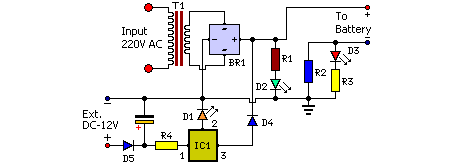Home » Circuits
Mobile Phone Battery Charger Circuit
Small and portable unit, Can be assembled on veroboardMobile phone chargers available in the market are quite expensive. The circuit presented here comes as a low-cost alternative to charge mobile telephones/battery packs with a rating of 7.2 volts, such as Nokia 6110/6150.
Circuit diagram:
Parts
R1 = 1K
R2 = 47R
R3 = 10R
R4 = 47R
C1 = 1000uF-25V
D1 = LEDs any color
D2 = LEDs any color
D3 = LEDs any color
D4 = 1N4007
D5 = 1N4007
IC1 = LM7806
T1 = 9VAC Xformer 250mA
BR1 = Diode bridge 1A
Circuit Operation:
The 220-240V AC mains supply is down-converted to 9V AC by transformer T1. The transformer output is rectified by BR1 and the positive DC supply is directly connected to the charger’s output contact, while the negative terminal is connected through current limiting resistor R2. D2 works as a power indicator with R1 serving as the current limiter and D3 indicates the charging status. During the charging period, about 3 volts drop occurs across R2, which turns on D3 through R3.
An external DC supply source (for instance, from a vehicle battery) can also be used to energies the charger, where R4, after polarity protection diode D5, limits the input current to a safe value. The 3-terminal positive voltage regulator LM7806 (IC1) provides a constant voltage output of 7.8V DC since D1 connected between the common terminal (pin 2) and ground rail of IC1 raises the output voltage to 7.8V DC. D1 also serves as a power indicator for the external DC supply. After constructing the circuit on a veroboard, enclose it in a suitable cabinet. A small heat sink is recommended for IC1.

